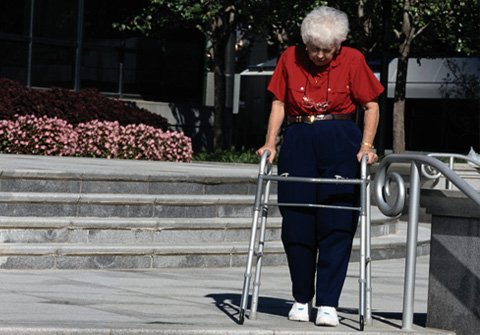Falls sustained by elderly people and the consequences arising out of them constitute a major problem for public health owing to their growing frequency and their potential for generating dependence. According to a study presented at the UPV/EHU's Department of Preventive Medicine and Public Health, it is possible at the very moment the fall occurs to spot those people who have an increased risk of achieving poor functional recovery.
The recovery of the elderly following a fracture depends on their physical and social situation
According to a study presented at the UPV/EHU-University of the Basque Country, the functional recovery of these patients depends on their physical and social situation beforehand and not so much on the characteristics of the fracture
First publication date: 20/07/2016

In order to assess the impact that hip and wrist fractures have on elderly people, researchers in the Research Network into Healthcare Services in Chronic Diseases (REDISSEC-ISCIII) have conducted a prospective study. "We noticed that the consequences of a fracture of this type were not the same in all people, and we tried to see whether there was some kind of profile of people whose progress was more likely to be poor," explained Itziar Vergara, a researcher in this research network and who has defended her PhD thesis on this subject at the UPV/EHU.
What affects functional capacity following a fracture is determined by a whole range of factors. As the study has revealed, in the case of hip and wrist fractures, the impact is greater the older the subjects are, the more associated diseases they have, the lower the level of education and the smaller the social support network is. A striking finding in the study was that functional recovery "is not linked either to the characteristics of the fracture or to the treatment provided. The interpretation we make of these results is that in our area, in the Basque Country, specifically in the public health service Osakidetza, which has been our source of information, the degree of professional and technological capability in the healthcare system for attending to and treating an individual with a fracture is so high that it is capable of making the outcome the same, no matter how complicated the situation of the fracture may be," she added. Taking this into consideration, what really influences whether or not the individual ends up generating dependence after a fracture is the starting point at which this individual was at when the fracture occurred," said Vergara.
The key, spotting frail elderly people
In an exercise in assessing all the fractures studied as a whole in terms of the significance they have from a public healthcare perspective, "we saw that the pattern of the subject who falls and who then achieves poor recovery mostly corresponds to what has in recent years been called a frail elderly person," said Vergara. They are elderly people who, despite remaining autonomous in their daily lives, are significantly weakened, and enjoy poor life quality in terms of health; they have a range of chronic disorders, high consumption of medications and a limited social support network.
Vergara believes it is very important to include this classification in the initial assessment by the healthcare assistance services. "Despite the complex assessments that can be made nowadays, we have not got as far as classifying the elderly with fractures as frail or robust, and it is certainly worthwhile paying attention to this label of frail elderly person, because we do in fact know that it is a person who is going to get worse and for whom it is worthwhile providing an integral response for his/her needs."
So "it would be a matter of finding out what key elements are making this person frail in order to try and overcome them, resolve them, and thus try and ensure that his/her recovery is as successful as possible," added the researcher. "Nursing, medical or geriatric personnel are totally capable of making this assessment. A huge amount of resources are not needed, all that has to be done is to focus on the things that are important for the elderly," she concluded.
Additional information
This research project was developed under the auspices of the collaborative REDISSEC-ISCIII research network, and was run at Osakidetza and at the Biodonostia Health Research Institute. These are the three pillars on which the PhD thesis by Itziar Vergara-Mitxeltorena (Irun, 1968) rests; it is entitled ‘Las caídas fortuitas que causan fracturas en las personas mayores: evaluación de su impacto en la funcionalidad' (Accidental falls causing fractures in elderly people: assessment of their impact on functionality), and supervised by José María Quintana, Head of the Research Unit at Hospital Galdakao-Usansolo, Osakidetza.
Bibliographical reference
Vergara I., Vrotsou K., Orive M., García S., González N., Las Hayas C., Quintana JM. ‘Wrist fractures and their impact in daily living functionality on elderly people: a prospective cohort study'. BMC Geriatrics (2016) 16:11
http://bmcgeriatr.biomedcentral.com/articles/10.1186/s12877-015-0176-z
Photos: UPV/EHU.

